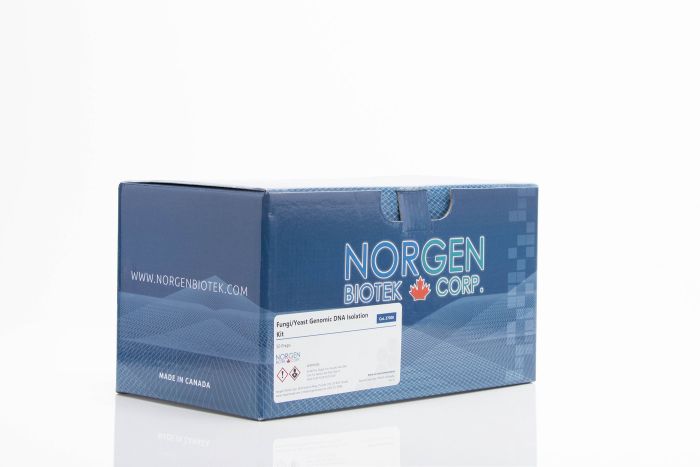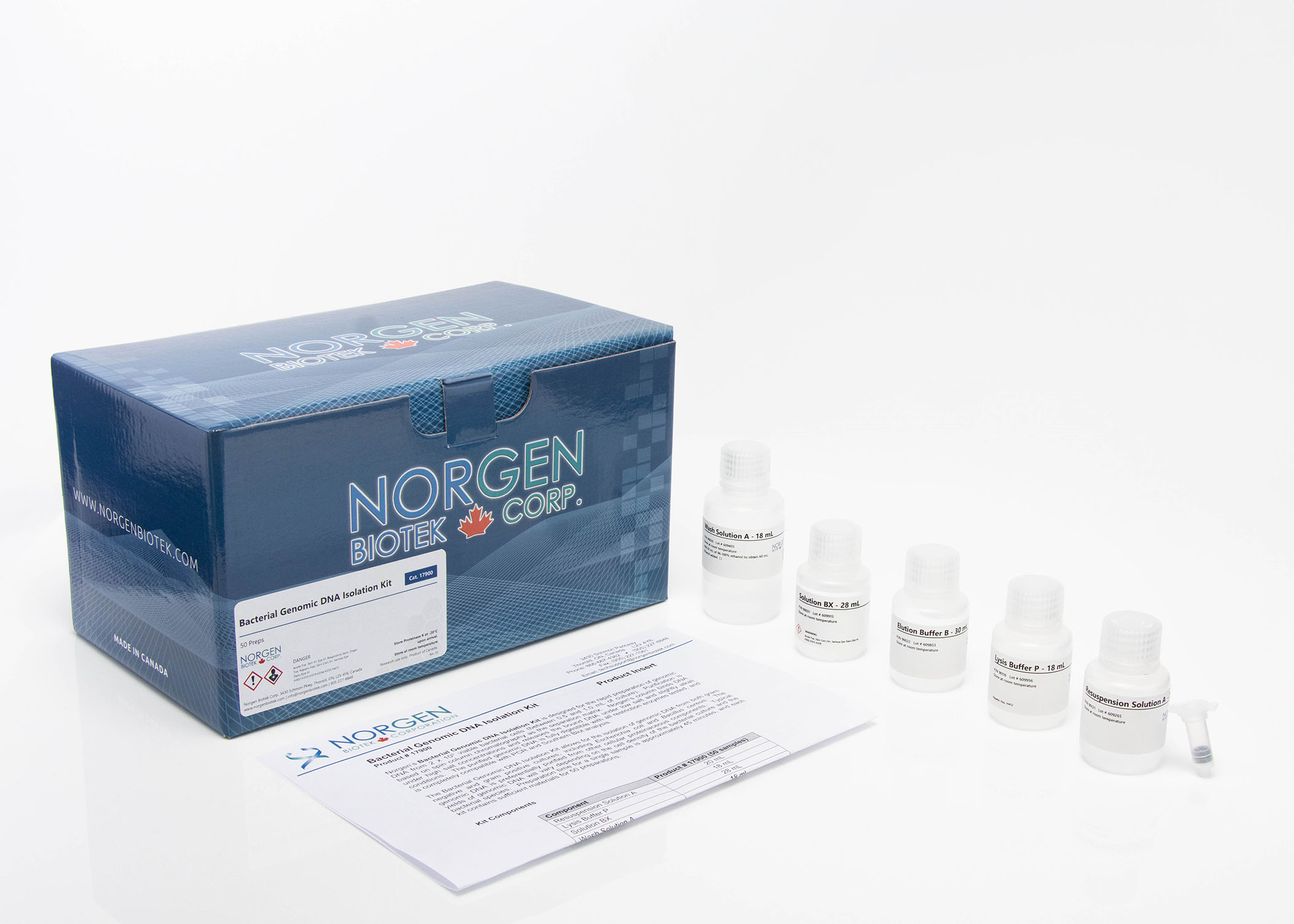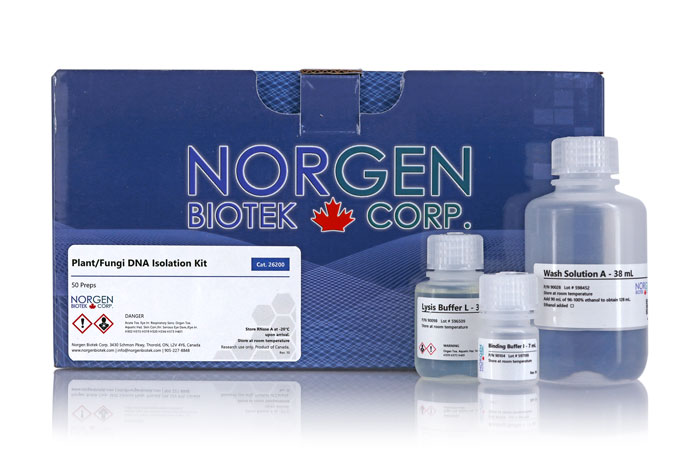Fungi/Yeast Genomic DNA Isolation Kits



For research use only and NOT intended for in vitro diagnostics.
Fungi/Yeast Genomic DNA Isolation Kits
Register today to receive an exclusive 15% off* on your first order.
Supporting Data
Figure 1. DNA Isolation from Different Fungi Species and Yeast. To demonstrate the purification of DNA from different fungal species, 30 mg of fungi were collected from plate cultures of Pichia sp, Aspergillus niger, Cladosporium cladasporioides, Botrytis cinerea and Mucor racemosus, and the DNA was extracted using Norgen's Fungi/Yeast Genomic DNA Isolation Kit. The bead system efficiently lysed the fungal cell walls with the provided Lysis Solution, and total DNA was eluted in 100 µL. For analysis, 10 µL from each elution was loaded in 1% 1xTAE agarose gel. Lane 1: Yeast (Pichia sp.), Lane 2: Aspergillus Niger; Lane 3: Cladosporium cladosporioides; Lane 4: Botrytis cinerea; Lane 5: Mucor racemosus; Lane M: Norgen's HighRanger 1kb DNA Ladder. The optional RNase treatment was not performed during the process.
Figure 2. DNA can be Isolated from Spores and Mycelium. Genomic DNA was extracted from the spores and mycelium of Botrytis cinera using Norgen's Fungi/Yeast Genomic DNA Isolation Kit. For the spores, 105 spores/mL were collected from a plate culture by adding 3 mL of 0.9% NaCl to the fungi culture plate and gently shaking to extract the spores. For mycelium, 20 mg of mycellium was collected with sterilized forceps. DNA was isolated using Norgen's Fungi/Yeast Genomic DNA Isolation Kit with the provided Bead Tubes. For analysis, 10 µL from each 100 µL elution was loaded on a 1% 1xTAE agarose gel. Lane M: Norgen's HighRanger 1kb DNA Ladder. Optional RNase treatment was not performed during the extraction. As it can be seen, DNA could be successfully isolated from both the spores and mycelium.
Figure 3. Identification of Fungal and Yeast Species in a Real-time PCR (SYBR Green). DNA was isolated from 50 mg samples (wet weight) of yeast (Pichia sp) and fungi including Aspergillus niger, Cladosporium cladasporioides, Botrytis cinerea and Mucor racemosus using Norgen's Fungi/Yeast Genomic DNA Isolation Kit, and 2 µL of each of the 100 µL DNA elutions was used in a qPCR (SYBR Green) reaction with specific fungal and yeast primers. The qPCR was successful in amplifying and detecting all the yeast and fungal DNA, indicating that the DNA is of a high quality and can be used in sensitive downstream applications.
Figure 4. High Yields of DNA Isolated from Saccharomyces cerevisiae overnight culture. DNA was isolated from S. cerevisiae overnight culture using Norgen's Fungi/Yeast Genomic DNA Isolation 96-Well Kit. Following isolation of 10 samples, 10 µL from each 100 µL elution was loaded on 1% TAE agarose gel. Norgen's Fungi/Yeast Genomic DNA Isolation 96-Well Kit demonstrated a good and consistent DNA yield and integrity. Lane M: Norgen's HighRanger 1kb DNA Ladder.
Figure 5. High quality of yeast DNA measured by NanoDrop. DNA isolated from Saccharomyces cerevisiae overnight culture using Norgen's Fungi/Yeast Genomic DNA Isolation 96-Well Kit showed a high quality of DNA based on A260/280 and A260/230. This indicates that the isolated DNA from all samples is of a high quality and can be used in sensitive downstream applications.
Figure 6. Purified DNA Can be Amplified in a Real-time PCR (SYBER GREEN) Reaction. DNA was isolated from Saccharomyces cerevisiae overnight culture using Norgen's Fungi/Yeast Genomic DNA Isolation 96-Well Kit. Five µL of the DNA from each 100 µL elution was used in a real-time PCR reaction (total reaction volume of 20 µL) with S. cerevisiae primers. The real-time PCR was successful in amplifying the S. cerevisiae from all 10 isolated samples. This indicates that the isolated DNA from all samples is of a high quality and can be used in sensitive downstream applications. The black line is a no-template control.
|
Kit Specifications
|
|
| Column Binding Capacity |
50 μg
|
| Maximum Column Loading Volume |
650 μL
|
| Maximum Amount of Starting Material: Fungi (wet weight) Yeast or Bacteria Culture |
50 mg 0.5mL - 1mL |
| Average Yield* Pichia sp. (yeast) Botrytis cinerea Fusarium sp. Aspergillis niger Mucor racemosus Cladosporium cladosporioides Penicillium sp. Rhizopus oryzae Alternaria tenuissima |
25 μg 32 μg 42 μg 26 μg 15 μg 12 μg 40 μg 7 μg 30 μg |
| Time to Complete 10 purifications |
30 minutes
|
* Yield will vary depending on the type of sample processed
Storage Conditions and Product Stability
All solutions should be kept tightly sealed and stored at room temperature. This kit is stable for 1 year after the date of shipment.
| Component | Cat. 27300 (50 preps) | Cat. 27350 (192 preps) |
|---|---|---|
| Lysis Buffer L | 30 mL | 2 x 60 mL |
| Resuspension Solution A | 20 mL | 60 mL |
| Solution BX | 28 mL | 2 x 28 mL |
| Wash Solution A | 18 mL | 2 x 38 mL |
| Elution Buffer B | 15 mL | 30 mL |
| Bead Tubes | 50 | 200 |
| Spin Columns | 50 | - |
| Collection Tubes | 50 | - |
| 96-Well Plate | - | 2 |
| 96-Well Collection Plate | - | 2 |
| Adhesive Tape | - | 4 |
| Elution Tubes (1.7 mL) | 50 | - |
| 96-Well Elution Plate | - | 2 |
| Product Insert | 1 | 1 |
Documentation
FAQs
Spin Column, High Throughput
Clogged columns/wells may occur due to the sample being too large:
- Too many cells were applied to the column.
Ensure that the amount of cells used is less than 1 x 108 viable yeast cells or 50 mg (wet weight) of fungal culture. Clogging can be alleviated by increasing the g-force and/or centrifuging for a longer period of time until the lysate passes through the column.
Turbidity in elution may be due to the sample being too large:
- Depending on fungi species, sometimes turbidity can be observed in the elution. This may inhibit downstream applications. Reduce the amount of cells used, and perform a third wash during the Wash step.
If the DNA does not perform well in downstream applications, it may be due to one or more of the following:
- The sample is too large.
Too many cells were applied to the column. Ensure that the amount of cells used is less than 1 x 108 viable yeast/bacterial cells or 50 mg (wet weight) of fungal culture.
- Ethanol carryover.
Ensure that the dry spin under the Column Wash procedure is performed in order to remove traces of ethanol prior to elution. Ethanol is known to interfere with many downstream applications.
- The columns/wells were not washed twice with the provided Wash Solution A.
Traces of salt from the binding step may remain in the sample if the column is not washed twice with the Wash Solution A. Salt may interfere with downstream applications, and thus must be washed from the column.
- PCR reaction conditions need to be optimized.
Take steps to optimize the PCR conditions being used, including varying the amount of template (20 ng to 50 ng for 20 µL of PCR reaction), changing the source of Taq polymerase, adding BSA (final concentration is 0.1 µg/µL), looking into the primer design, and adjusting the annealing conditions.






